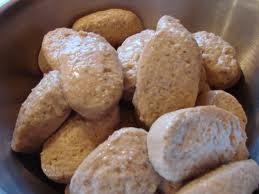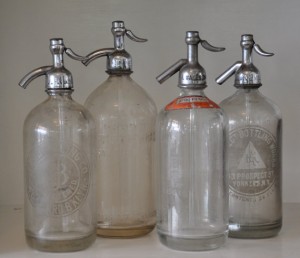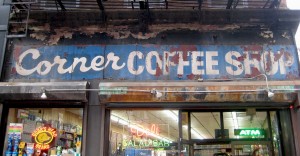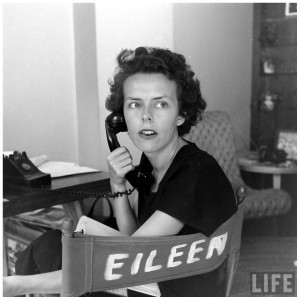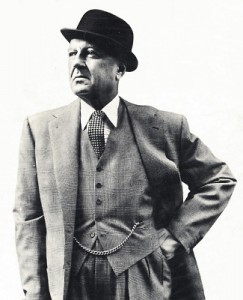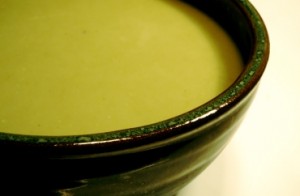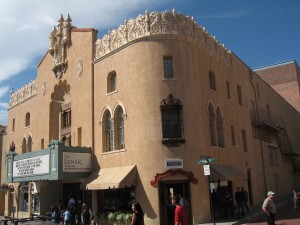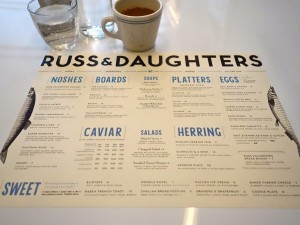HG misses a champion quality warm weather dish: the Gefilte Fish prepared by HG’s late Mom. Often maligned due the rubbery, jellied, mass produced version served from a jar on Jewish holidays, Gefilte Fish means “stuffed fish.” But, this is misleading. The Gefilte Fish that we have come to know consists of chopped freshwater fish combined with matzo meal, eggs, grated onion and white pepper. This forcemeat is formed into balls, poached in strong fish broth and served cold with the jellied broth and strong horseradish — essentially a Jewish quenelle. Egg bread (challah) is the appropriate accompaniment. Little HG often acted as Mom’s sous chef in the preparation of Gefilte Fish. HG grated onion and horse radish and tried not to inhale the pungent fumes or scrape his knuckles on the box grater. Removed the fish heads and bones from the fish stock and dumped them in the garbage can. HG’s Mom chopped four varieties of fish — carp, pike, whitefish and buffel. This last fish, buffel, was a mystery to little HG. Years later HG learned this was a reference to Buffalo Fish. Buffel was the Yiddish translation (or Yinglish). These days Buffalo Fish can only be found at fishmongers in New York’s Chinatown. HG’s Mom used a high proportion of carp. This gave her fish balls a richer flavor and a much darker color than most other versions. Carp is native to China and was brought to Europe in the 17th Century by Jewish traders (and others) working the silk routes. Jews began cultivating carp in special ponds and it quickly became a significant holiday dish in Eastern European homes both Jewish and Gentile. Its popularity spread and “Carpe a la Juive” (jellied carp prepared in the Jewish style) rated four entries in France’s encyclopedic Larousse Gatronomique. HG’s Mom often prepared it. Not an HG favorite. HG preferred her rich and velvety Gefilte Fish — a humble and delicious dish with a sullied reputation.
Gefilte Fish
August 12th, 2014 § 0 comments § permalink
Department Store Dining
August 6th, 2014 § 0 comments § permalink
There’s been a long tradition of New York department stores containing some fairly beloved restaurants. The intent, obviously, is to keep the customer in the store and keep her shopping (the gender specific “her” is probably an out-dated notion, but NY’s department stores were initially created for and catered to an almost exclusively female audience). Tea sandwiches, salads and exuberant desserts were featured. Gourmands sneered at these dainties but during HG’s days in New York, HG often lunched in department stores. HG’s favorite was Lord & Taylor. The store broke with tradition by operating a soup bar. A very large African-American man wearing a chef’s toque ladled soups from a big kettle. The soup was served with Ritz crackers and was a cold weather treat. Dignified B. Altman (long gone) on 34th and Fifth was famed for ladies’ intimate apparel and high quality furniture. The restaurant was classy. The hands down favorite of fashionable women was Bergdorf Goodman with restaurants in the basement and on a high floor (spectacular Central Park views). Alex Witchel of The New York Times did a charming story (in 2013) about lunching there with writer Patricia Volk. Paris, of course, has the best department store restaurants. Bon Marche’s are the height of chic but for variety nothing tops Galeries Lafayette. There’s a dim sum restaurant, an oyster and fish eatery, Italian restaurant, Spanish counter with the best Serrano ham. There’s pizza, tapas, paella, Indian tandoori..and more.. (HG’s pal, journalist/wine expert/author Peter Hellman did a nice article on Paris department store dining for The New York Times some years ago). In addition to dining, Bon Marche and Galeries Lafayette have stupendous food and wine departments. Bon Marche’s, the Epicerie, is epic. HG/BSK have many happy memories of smoked salmon, country pate, jambon persille, countless varieties of perfectly ripened cheese and savory charcuterie. The makings of exuberant dinners with wine and fresh baguettes in HG/BSK’s rented Paris apartments. Of course, the glories of Paris department store dining and food halls (including the splendid one at London’s Harrod’s) dwindle when compared to the limitless cornucopia of delicacies offered at KaDeWe, the Berlin department store (largest in Europe). There are two vast floors of food plus a rooftop cafeteria. HG/BSK plan to be there sometime in the future and indulge in oysters and champagne plus many other good things from every part of the world.
Bittman Attacks French Food
July 26th, 2014 § 0 comments § permalink
Mark Bittman, the seemingly omnipresent food writer, did a recent op-ed piece in The New York Times bewailing the state of restaurants in France and their reliance on food “cooked at a faraway factory.” He is quite harsh in his opinions concerning Paris restaurants (he has to research and eat at three in order to find one good one). Bittman exaggerates (slightly). Sure, there are bad restaurants in France (as in every country) where owners pay more attention to profit than dining pleasure. And, sure, Paris is no longer the dining capital of the world. New York has taken over that spot. In addition to world class dining experiences like Per Se, Bernardin, etc., mighty Noo Yawk has an almost limitless array of interesting ethnic restaurants ranging from the entire spectrum of Korean and Chinese restaurants in Flushing to Ghana taxi driver food on the Grand Concourse in The Bronx to Uzbekistan eateries in Rego Park. And, if you want to recapture the golden age of French cuisine replete with lush flowers, deft service and classic dishes, one can turn back the clock and empty one’s wallet at La Grenouille on Manhattan’s posh upper East side. And, then there’s Brooklyn with its astounding metamorphosis into the world’s center of hipness with a multitude of food experiences to match its style. But, Paris, though no longer the ultimate gourmand destination, still has much to offer. Super baguettes and Poilane bread. Very good oysters (and guys who know how to shuck them). The best cheese and butter (Bordier). Wine shops stocked with splendid affordable vintages. Cafes, for the most part, offer mediocre food but world class viewing of stylish women (of all ages, thankfully). Bittman has a point. It’s not easy to find restaurants where fresh food is prepared on the premises. HG’s advice: Consult Alec Lobrano’s Hungry for Paris guide and John Talbott’s website. In Paris, HG spends much time at museums and cinemas. When it comes to food, HG is downscale. Favorite hangout is the back room of La Cave des Abbesses, a Montmartre neighborhood wine shop. In this very bare bones place, HG likes to linger over a platter of cheese with a carafe of red wine. In season, there are oysters for one Euro a piece. HG manages to get down a dozen with ease. La Cave is a nice place to visit after listening to the street musicians (usually quite talented) on the Place des Abbesses. HG also likes the gritty Arab/African neighborhood of Montmartre for couscous and other Maghreb specialties. Jour et Nuit is a good place for a hearty meal with the locals. Big flavors. Tiny prices.
Two Cents Plain
July 22nd, 2014 § 1 comment § permalink
Many, many decades ago young HG was an after school soda jerk at Bonder’s Candy Store on West Kingsbridge Road in The Bronx. The most requested beverage was simple: A Two Cents Plain. What is that? Well, it is a glass of cold seltzer that cost two cents. A very modestly priced thirst quencher. The older Bronx population believed seltzer was an aid to health and digestion. The local tradesmen would pop into the candy store a few times every afternoon, swallow a two cents plain and emit a hearty belch.(A greps in Yiddish). Bronx digestive therapy. A seltzer bottle (siphon) was always on the HG family dining table (along with a nice jar of schmaltz). A delivery service picked up the empties and replaced them with full bottles. The seltzer truck was a familiar sight. There is one last Seltzer delivery service in New York — Brooklyn Seltzer Boys According to HG’s research, other than New York, seltzer in its familiar siphon is still delivered on a daily basis in Vienna, Toronto and some Argentine cities. A nice urban amenity.
The Coffee Shops Of NYC
July 17th, 2014 § 1 comment § permalink
The coffee shop is a New York institution, a basic eating place for generations of busy New Yorkers. A place to meet. A place to wait for a movie to start. A place to finish a date over some chocolate cake. No, HG is not talking about the espresso cafes in Greenwich Village frequented by voluble intellectuals, pseudo and genuine. HG is talking about that blend of diner, restaurant, fast food dispenser and “greasy spoon” (an unfair description) unique to New York. HG doesn’t know whether they should be written about in the present or past tense since so many have been the victims of the real estate plague where neighborhood landmarks have been replaced by banks or retail chains. In any case, the coffee shops vivid in HG’s memory were owned by Jews or Greeks. If owned by Jews you could linger over coffee with a bialy, cream cheese, the Times and the News (plus a pack of Marlboros, of course). Greek places had excellent soups, superior hamburgers sizzled on the griddle and some Greek specialties (HG remembers with fondness platters of fried chicken livers and onions served over pilaf). Coffee shops served breakfast all day. BLT’s and tunafish sandwiches were staples. Coffee shops did not strive to scale culinary heights. Their emphasis was on speed and efficiency. Those cooks working behind the long counter could get a lunchtime crowd in and out in a hurry. Home made food, no pretensions, no minimum charge — a boon to New Yorkers through the decades.
Eileen Ford
July 11th, 2014 § 0 comments § permalink
Eileen Ford, the grande dame of model agencies, died this week and received a rather reverential front page obituary in the New York Times. The obit did mention, however, that the lady could be nasty and imperious with would-be models. She sure was with young BSK in l963. BSK met with Ford in hopes of doing some part time modeling (the HG/BSK bank balance needed some augmentation). Ford, clad in a proper skirt and sweater twin set, disapproved of BSK’s clothes: A stylish Tuffin and Foale maroon melton pants suit. Pants were not appropriate for wear in a city, said Ford. Ford suggested BSK lose 16 pounds and get a nose job if she wanted a modeling career. BSK did not take Ford’s counsel. BSK continued to eat sensibly, wear pants and breathe through an unaltered nose, a distinguished mark of BSK’s Norman ancestry. Two years later, BSK (and baby daughter Lesley) were featured in a photo layout in the New York Herald Tribune (the newspaper that harbored Jimmy Breslin, Tom Wolfe and other outstanding journalists while giving birth to what became today’s New York Magazine). The article was about BSK’s way with fashion (the writer/editor Eugenia Sheppard called BSK “a pants addict”). Ms. Sheppard found BSK to be elegantly svelte and dubbed her “a hipless hippie.” An interesting piece of observation since BSK was neither “hipless” nor a “hippie.” Oh, well. The years have rolled by. Fashion and much else has changed radically. BSK remains a constant. Still a beautiful pants addict.
Fresh and Simple Lunch at Cookshop
July 8th, 2014 § 0 comments § permalink
Was it Lucius Beebe (or Oscar Wilde) who said (and HG paraphrases): “My tastes are simple. I like only the very best.” ? HG agrees (in part). HG deplores over elaborate, over sauced, fussed over food. Through the years HG dined at many temples of high cuisine (Le Pavillon, Lutece, La Cote Basque, Le Bernardin in New York; Connaught Restaurant and Savoy Grill in London; the once glorious Laperouse in Paris). Even in these vaunted places, HG ordered simple dishes (mixed grill at the Connaught; grilled sole at the Savoy and roast duck with turnips at Pavillon). HG may be accused of favoritism and family pride, but HG’s ideal of dining is Cookshop, the restaurant run by HG’s daughter, Victoria Freeman,and her husband, chef Marc Meyer. It is located on Tenth Avenue in New York’s Chelsea neighborhood and is always filled with a lively, good looking crowd. The restaurant has been in the forefront of the farm-to-table, locavore movement. Meyer treats his superior ingredients with restraint and imagination. A tip from HG. Settle down with a glass of chilled rose (from Slovenia, surprisingly). Have some radishes with herbed butter and sea salt. Follow with roasted asparagus (sauce gribiche). Then, share a Hudson Valley Chicken Breast Salad. This is not the usual mayonnaise-drenched mess. The menu describes it this way: “Chicken, arugula, cucumbers, sliced carrots, radish, spiced walnut, golden raisin, sherry vinaigrette.” Crunchy with summery flavors and hints of salt and sweetness. HG shrugs off charges of nepotism. Can one imagine a better summer lunch? (An afterthought: Alexander Lobrano, the Paris-based food writer for the New York Times and many other publications and the author of the best guide to Paris dining, Hungry For Paris, dined at Cookshop while visiting New York. He expressed a wish that Paris should have more restaurants like Cookshop).
Summer Heat Beater: Schav
July 6th, 2014 § 0 comments § permalink
HG has noted previously that BSK has cultivated a lush crop of sorrel. BSK makes very good sorrel soup in the French manner. Thickened and enriched with a touch of sweet cream, it is the perfect sauce for grilled or poached salmon. Vaudeville, the art deco Paris brasserie, served a very good version (before the brasserie went downhill under chain management). However, HG’s favorite use of sorrel is in “schav”, the ice cold, refreshingly sour sorrel soup as it was prepared by HG’s Mom and served in New York Jewish “dairy” restaurants (and Catskills resorts) in years gone by. Topped with some sour cream, this soup conquers summer heat. Accompanied by a boiled potato, this was often HG’s boyhood summer lunch in The Bronx and Rockaway. Weather has been hot and humid on PEI. HG”s palate cried out for schav. So, consulting the Jew and Carrot food blog, HG made a jar of schav. Very good. But, it lacked something, A bite of sourness. What was Mom’s secret? Memory was racked. The answer: Rokeach Sour Salt. Essentially citric acid, this is what Mom added to her schav, exemplary beet borscht, robust cabbage borscht and savory ground meat stuffed cabbage in sweet and sour sauce. Yes, Rokeach still provides sour salt and HG is waiting for a supply from Amazon.
Movie Heaven — The Bronx Gets Slapped By Santa Fe
June 20th, 2014 § 0 comments § permalink
Depressing fact reported by The New York Times: The Bronx, with a population of 1.4 million, contains two movie theaters (multiplexes with a combined total of 23 screens). When HG grew up in The Bronx, there were scores of movie theaters ranging from palaces (Loew’s Paradise, The Interboro, etc.) to intimate art houses (The Ascot). Fordham Road, in a six block expanse, contained The Lido, The Concourse, Loew’s Grand, The Valentine and The Fordham. “Going to the movies,” like rooting for the Yankees and eating pastrami and pizza, was an integral part of Bronx life. HG/BSK are fortunate to live in Santa Fe. “The City Different” has a population of 80,000 which supports three multiplexes (and another in a nearby community) plus three cinematheques. In terms of movie going, it’s almost like living in Paris. Santa Fe also has opera housed in a spectacular setting; live theater, dance and concerts at The Lensic (a beautifully restored old venue); live music in lots of clubs ranging from the raucous to the sophisticated. And, of course, Santa Fe has art: A dozen museums and numerous galleries plus world famous annual Native American and Hispanic art markets. And, the weather is great. Plus you are never far from a breakfast burrito smothered in green chile sauce. Heaven.
Big $$ For Old Time Treats
May 28th, 2014 § 0 comments § permalink
Eight dollars for an egg cream. You read it right. That’s what that old timey New York candy store beverage costs at Russ & Daughters Cafe, recently opened on Orchard Street in New York’s Lower East Side. Scrambled eggs and caviar: $180. A helping of Transmontanus caviar: $175. Don’t know what a plate of kasha varnishkes costs or the price of bagel-Nova salmon-cream cheese. Presume they are lofty numbers. Since the smoked fish and caviar comes from the venerable Russ & Daughters “appetizing” store around the corner on Houston Street, HG presumes it’s all mighty tasty. But, those prices!! These are noshes meant for Russian oligarchs. The Russ & Daughters store has been a longtime favorite of HG/BSK and family. The store has been around for 100 years and has a devoted, fiercely loyal customer base. SJ is often first on line waiting for the store to open during Christmas season. SJ spends about $200 and gets enough culinary marvels for HG/BSK, the Riva family and SJ’s family to enjoy their gala Jewish/Russian/New York version of the traditional Italian Christmas Eve “Feast of the Seven Fishes.” When HG/BSK lived on Sheridan Square in Greenwich Village, HG was at R & D every Sunday morning. HG often encountered Calvin Trillin, the New Yorker and The Nation writer. Among many attainments, Trillin was the poet laureate of Russ & Daughters. HG’s pal, Peter Hellman, the distinguished journalist and wine authority, performed a similar function for Zabar’s, the megalopolis of smoked fish and much else, located on the Upper West Side. HG will continue to order R & D treats online. Unless there are some price adjustments, HG will stick to take-out and forgo the Cafe.
